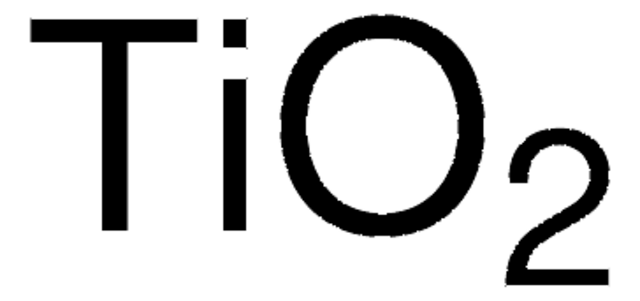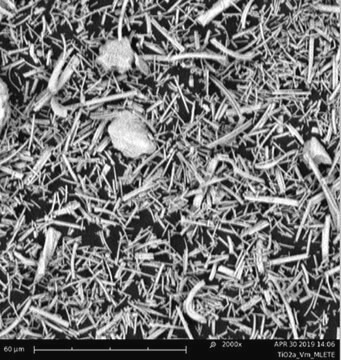推荐产品
检测方案
≥99.9% trace metals basis
形式
powder
反应适用性
reagent type: catalyst
core: titanium
粒径
<5 μm
密度
4.17 g/mL at 25 °C (lit.)
SMILES字符串
O=[Ti]=O
InChI
1S/2O.Ti
InChI key
GWEVSGVZZGPLCZ-UHFFFAOYSA-N
正在寻找类似产品? Visit 产品对比指南
一般描述
应用
金红石氧化钛(IV)具有高介电常数,可用作低温共烧陶瓷(LTCC)的成分,或用作有机-无机复合材料的填料。
Au/金红石TiO2 可作为光催化剂用于胺的选择性有氧氧化形成相应亚胺。
特点和优势
其他说明
储存分类代码
13 - Non Combustible Solids
WGK
nwg
闪点(°F)
Not applicable
闪点(°C)
Not applicable
个人防护装备
Eyeshields, Gloves, type N95 (US)
分析证书(COA)
输入产品批号来搜索 分析证书(COA) 。批号可以在产品标签上"批“ (Lot或Batch)字后找到。
已有该产品?
为方便起见,与您过往购买产品相关的文件已保存在文档库中。
难以找到您所需的产品或批次号码?
如何查找产品货号
在网站页面上,产品编号会附带包装尺寸/数量一起显示(例如:T1503-25G)。请确保 在“产品编号”字段中仅输入产品编号 (示例: T1503).
示例
其它示例:
705578-5MG-PW
PL860-CGA/SHF-1EA
MMYOMAG-74K-13
1000309185
输入内容 1.000309185)
遇到问题?欢迎随时联系我们技术服务 寻求帮助
如何查找COA批号
批号可以在产品标签上"批“ (Lot或Batch)字后面找到。
Aldrich 产品
如果您查询到的批号为 TO09019TO 等,请输入去除前两位字母的批号:09019TO。
如果您查询到的批号含有填充代码(例如05427ES-021),请输入去除填充代码-021的批号:05427ES。
如果您查询到的批号含有填充代码(例如 STBB0728K9),请输入去除填充代码K9的批号:STBB0728。
未找到您寻找的产品?
部分情况下,可能未在线提供COA。如果搜索不到COA,可在线索取。
Which document(s) contains shelf-life or expiration date information for a given product?
If available for a given product, the recommended re-test date or the expiration date can be found on the Certificate of Analysis.
How do I get lot-specific information or a Certificate of Analysis?
The lot specific COA document can be found by entering the lot number above under the "Documents" section.
How do I find price and availability?
There are several ways to find pricing and availability for our products. Once you log onto our website, you will find the price and availability displayed on the product detail page. You can contact any of our Customer Sales and Service offices to receive a quote. USA customers: 1-800-325-3010 or view local office numbers.
What is the solubility of Product 224227, Titanium(IV) oxide, rutile?
We do not test the solubility of this product. However, according to the chemicals encyclopedia published by the Royal Society of Chemistry, 13th Edition, this product is insoluble in water, HCl, HNO3 and dilute H2SO4. It is expected to be soluble in hot concentrated H2SO4 and hydrofluoric acid.
What is the surface area of Product Product 224227, Titanium(IV) oxide, rutile?
According to our supplier, the surface area of this product is about 2-3 m2/g.
What does "Trace Metal Basis" mean?
For this product, the purity is determined by testing total metallic impurities. Our specifications only allow for a maximum of 1000 ppm. On the Certificate of Analysis, you will be able to see which metals were tested and the amount.
How much anatase is present in Product 224227, Titanium(IV) oxide, rutile?
We do not determine the amount of anatase form present. However, according to our supplier, this product may have a maximum of 10% anatase present.
What is the Department of Transportation shipping information for this product?
Transportation information can be found in Section 14 of the product's (M)SDS.To access the shipping information for this material, use the link on the product detail page for the product.
My question is not addressed here, how can I contact Technical Service for assistance?
Ask a Scientist here.
我们的科学家团队拥有各种研究领域经验,包括生命科学、材料科学、化学合成、色谱、分析及许多其他领域.
联系技术服务部门
